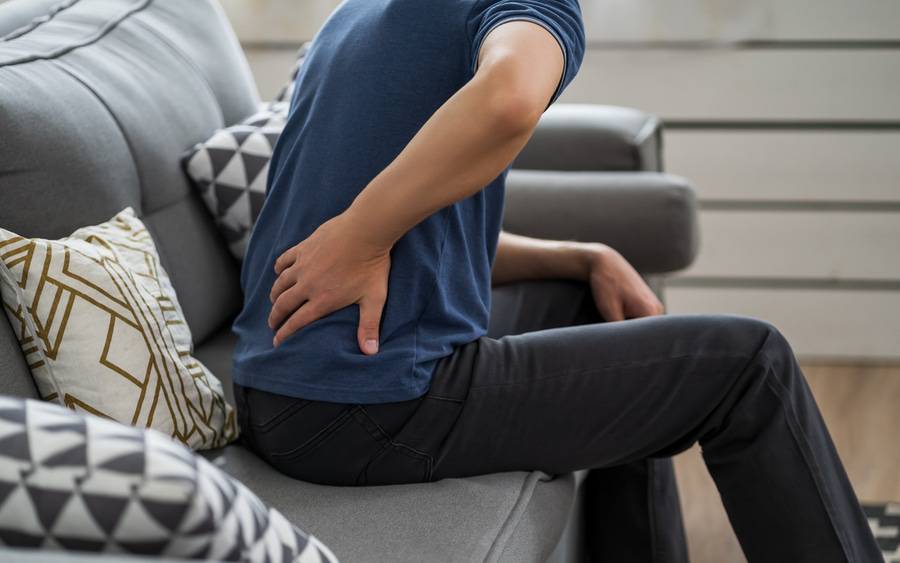What Are the Different Types of Back Pain?
Learn how back pain symptoms affect people in different ways

Learn how back pain symptoms affect people in different ways
Back pain is one of the most common complaints among adults of all ages — and often one of the hardest to pinpoint. There are different types of back pain.
Pain in the back can mean an annoying ache that comes and goes, a debilitating spine condition, and everything in between.
“Pain can develop anywhere along the spine or in the back muscles of the back,” says Timothy Peppers, MD, a spine surgeon at Scripps Clinic Encinitas and Scripps Clinic Jefferson in Oceanside. “Trauma, such as accidents or falls, can cause sudden, sharp pain that usually resolves on its own, while osteoarthritis or other illness may cause chronic pain that comes on slowly.”
Spinal anatomy and back pain
The back is made up of the spine itself and the associated ligaments, tendons, and muscles. Also known as the backbone, the adult spine consists of 24 stacked bones called vertebrae. Between the vertebrae are spongy discs that cushion the bones and ligaments that hold them in place.
The spine surrounds and protects the spinal cord, which is a long bundle of nerves that runs down back from the brain to the tailbone and sends messages from the brain throughout your body.
What are the main spinal regions?
The spine has three regions:
The cervical spine consists of the seven vertebrae at the top of the spine. It supports your head and allows you to bend and turn your neck.
The thoracic spine includes the 12 vertebrae in your upper and middle back. It attaches to your ribs to give stability to your upper body.
The lumbar spine comprises the remaining vertebrae in your lower back and helps you bend and twist. It has much more mobility than the thoracic spine, so it is more prone to injuries and damage from everyday movement.
Four types of back pain
Here’s a look at some of the most common types and causes of back pain.
1. Feeling stiff or sore
Tight or sore muscles can happen in all three regions of the spine. Stiffness in the muscles that control the neck and attach to the shoulders often cause cervical spine pain. Tension in these muscles can lead to headaches. Putting too much strain on these muscle during exercise (such as pull-ups) or other activities that involve the neck muscles can make them tight and tense.
“We see a lot of neck strain that occurs as a result of extending the neck forward or down for prolonged periods of time while working on a computer or using a mobile device,” notes Dr. Peppers. “It’s important to be aware of your posture when you’re using devices and take breaks.”
Middle or lower back muscle pain often stems from strain or injury to the muscles and ligaments of the thoracic or lumbar spines. Twisting too far or too quickly can strain the middle or lower back, while weight gain or pregnancy can put excess pressure on the area. If your core muscles are weak, or you have poor posture, you may be forcing your back muscles to compensate.
Lower back muscle injuries are frequently caused by sports, accidents or overexertion; for example, lifting heavy objects can easily strain the lower back. In addition, these muscles are more likely to and often do spasm, causing sharp, debilitating pain.
Rest and massage can help strained or tense muscles relax.
2. Sudden, sharp pain
Sharp, burning or shooting pain that may be accompanied by a feeling of “pins and needles” is typically related to a pinched or irritated nerve in the spine. Nerve pain travels away from the spinal cord and follows the path of the nerve, so nerve pain from your neck may feel like it is shooting down your shoulder or into your arm.
Shooting or burning pain in the lower back and buttocks, called sciatica, is caused by pressure on the sciatic nerve that travels through the buttocks and down the back or side of the leg.
Several conditions may irritate nerves. Spinal stenosis is the narrowing of the spinal column, often in the neck or lower back, which puts pressure on the spinal cord. Osteoarthritis also can lead to spinal stenosis.
3. Persistent pain, numbness or weakness
Any of these may be due to pressure on a nerve from a herniated disc. Also known as a slipped disc, a herniated disc occurs when the cushioned part of a disc is forced through a weakened area.
Spondylolisthesis, a condition in which a vertebra in the spine slips forward on the bone below it, can cause any of the above-described symptoms in the lower back or down the leg, along with tightness in the hamstrings and buttocks.
4. Intermittent pain that worsens with activity
Inflammatory back pain, caused by inflammation in the joints of the spine, can come and go during the day and may feel worse with exercise or activity. Lying down may help relieve the pain.
Inflammatory back pain is often linked to ankylosing spondylitis, an inflammatory disease that can cause some of the vertebrae to fuse.
Other causes include autoimmune diseases and infections.
Compression fractures of the vertebrae may also cause pain. They typically occur in people who have osteoporosis, a condition that causes bones to weaken and become brittle.
Other causes of back pain, especially in the lower back, can include kidney infection, kidney stones, endometriosis and tumors.
How to alleviate back pain at home
Simple lifestyle changes can help prevent back pain, including stretching and other exercises.
“There are so many potential reasons for back pain, and many ways to help relieve it,” says Dr. Peppers. “If your pain is severe or prolonged, see your doctor to rule out anything serious and find the right treatment.”
Back surgery may be an option when non-surgical approaches don’t work, including minimally invasive procedures.